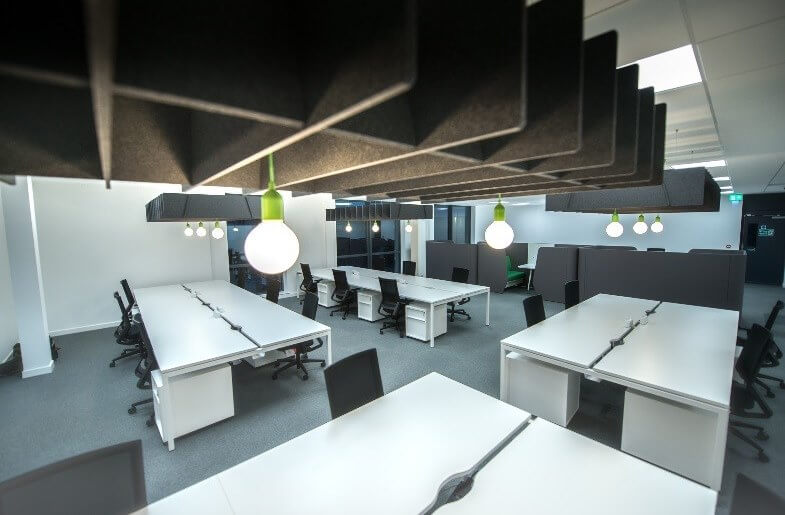Whether you’ve been in your current workspace for two years or 20 years, more often than not there are improvements and efficiencies to be made.
This guide sets out some of the main reasons for refreshing and upgrading your office environment.
What are the benefits?
1. Create an intelligent layout
When you look around your workspace, does it look like much thought was put into how it was configured? Or have equipment and furniture simply been placed where the nearest power points are? With an office fit out you’re afforded the freedom and flexibility to design the space to fit your needs.
2. Put safety first
The health, safety and wellbeing of your staff are of utmost importance and should never be compromised. When undergoing plans for a fit out, your current office space should be appraised and the new one designed around what’s safest for staff and visitors alike. Considerations should include laying slip-resistant floors, maximising natural light and safely installing fixtures and fittings.
3. Update your facilities
Even seemingly small measures can go a long way to enhancing your working environment. Upgrading fittings in communal facilities like kitchens and bathrooms helps to give the whole space a facelift, while making staff feel valued.
4. Improve communication
Although communication via technology has never been easier in the workplace thanks to digital advancements, concerns have been expressed that it comes at the expense of face-to-face, human interaction.
Introducing a fully collaborative workspace — or simply integrating a few areas that encourage collaboration — can help to improve staff engagement and creativity
if that’s what your organisation requires.
5. Invest in a morale boost
Let’s face it, we spend almost as much time at work as we do at home. Think about how demoralising it can be if the workspace is tired, grey and uninspiring. By investing in improvements you are making a statement that you care about the wellbeing and satisfaction of your staff, thus boosting collective morale
and counteracting the effects of work-related stress and anxiety.
6. Cultivate calm
The noise and bustle of a busy office can be stressful and,
as research has shown, stress has a tendency to spread in communal environments. But an office redesign gives you the opportunity to introduce designated ‘quiet zones’, which can be used for working without distractions, private meetings or just having a few minutes’ downtime.
7. Give productivity a push
It’s proven that happy staff are more productive than employees who feel overworked and undervalued. Making people feel stimulated and inspired at work – including through their working environment – is likely to increase output and therefore revenue. There are many factors —
some of which may seem small — that affect how employees feel when they’re at work; lighting, WC and kitchen facilities, temperature and noise levels, for example. An office fit out can address all of these crucial elements and more, to ensure you’re getting the best out of your staff.
8. Keep up with regulations
Legislation around working conditions is regularly updated and businesses have a duty to adhere to it, otherwise they can be liable for fines. This includes meeting
energy efficiency guidelines, so it’s important to make sure your office fit out is as sustainable as possible.
For more benefits that could come with investing in a redesign of your workspace, see our page
What to consider when planning an office fit out.
Should I move to a new office or improve my existing one?
Changing your office environment is no small undertaking and can understandably cause stress and disruption to the business. But when you consider the benefits it could bring to staff wellbeing, morale and productivity, as well as client perceptions, the investment is well worth it.
Many businesses go through the process of considering whether a refit of their current office space is the best option, or whether it would simply be easier or more cost-effective to relocate to another office.
Here are a few pointers to help you decide:
|
Relocating to a new office space
|
Redesign/fit out of current office space
|
| Opportunity to upsize or downsize space as needed |
Opportunities to refresh and optimise existing space through clever design and fit out |
| High initial costs, including migration fees and cost of dilapidations |
Potentially lower costs, no migration fees |
| Upheaval of organising the move – viewing offices, deciding on location, budgeting etc – which can distract from day-to-day business |
Can be disruptive but usually less downtime than a full move – if necessary staff can be moved to a temporary onsite office |
| Risk of losing staff if new location is unfeasible for them to commute to |
Reconfiguring existing office can free up additional space that could be sub-let |
| Starting afresh can increase productivity, impress clients and attract new staff |
A good redesign and fit out will make the existing space feel just as fresh, renew staff motivation and impress clients |
Considering the potential investment and upheaval of coordinating a full office relocation, Dale is on hand to help you find alternative solutions wherever possible to minimise disruption and maximise the effectiveness of your business. This includes providing on-site accommodation for staff if necessary during the refit.
Before and after: Dale transformed the office space of Sheffield-based company Zoo Digital with this successful fit out project
How much would a fit out cost?
The cost very much depends on variables such as the size of the office, the number of employees occupying it, the location and the level of refurbishment that’s required.
For example, if the installation were to include the flooring, ceiling, lighting and two meeting rooms, a typical cost could be £20 per square foot. But if furniture, fittings and equipment (known in the trade as FF&E) were also required, then the cost would go up accordingly.
Further detail about costings can be found on our
typical costs of an office fit out page.
What type of fit out would I need?
Category B fit out
This is
the most common type of fit out, whereby everything you need is installed and you can choose the layout and décor to make the space your own.
Category A and B fit out
If your current workspace is really dilapidated, there may be a need to rebuild its shell before embarking on the category B fit out. This can be a sensible option if, for example, you wish to change the mechanical and electrical systems to improve efficiencies.
You can find out more about the types of fit out and what they involve in our
guide to cat a and cat b fit outs.
How long will the fit out take?
This is one of the most common questions we’re asked, and an important consideration when you’re looking into an office fit out. If you decide to go ahead, we’ll be able to give you a timeframe that’s tailored to your individual project so that you can prepare for it in good time. But to give you an idea,
take a look at our typical fit-out schedule.
Do I need to move staff off site during the fit out?
Not necessarily. While it can depend on the scale of the improvements being made, we aim to avoid it where possible by:
- Carrying out as much work as possible off site
- Working in zones on-site that allow part of the office to remain operational
- Employing staff who understand the need to minimise disruption.
If we feel a smart way to keep your business running smoothly is to relocate staff temporarily, we will plan this with you in advance and arrange for temporary cabins to be set up on-site for your staff to work out of.
How do I manage my staff through the office fit out or move?
Here are 5 things you can do to support staff through the change brought by an office fit out or move:
5 tips for effective change management
- Be transparent
Employees need to be kept in the loop from the beginning about the plans. Make sure you ask for their opinions and input on what should be changed.
- Listen
Taking on board the feelings of your staff is crucial to making changes successfully, otherwise resentment can build. An online ‘suggestions box’ where staff can leave comments anonymously can be a good idea.
- Share the workload
Another way to involve staff is to delegate parts of the project to them, allowing them to contribute to the end goal and think creatively.
- Show enthusiasm
Positivity goes a long way and placing value on the plans, but also the team members helping to implement them, is key to a successful transition.
- Be adaptable
Staying open to the prospect of changing elements of the plan as you encounter obstacles is important, but keep employees engaged by remaining focused on your goals.
Interested in updating your office environment?
Contact the Dale team on
0114 233 1115.
Further resources
See
examples of our projects
Visit our
advice centre
Watch
what we can do






